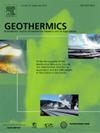漳州花岗岩高温水冷处理细观损伤机理及物理力学性能
IF 3.9
2区 工程技术
Q3 ENERGY & FUELS
引用次数: 0
摘要
为了开发深部地热资源,全面了解高温岩石水冷却后的细观损伤机制和物理力学性质是至关重要的。本文对花岗岩进行了不同温度(20°C、150°C、300°C、450°C、600°C和750°C)的水冷却实验,并通过计算机断层扫描、光学电子显微镜和核磁共振定量评价了相应的微观结构损伤程度。分析了花岗岩的单轴抗压强度和弹性模量。结果表明:随着加热温度的升高,花岗岩中裂纹的数量和尺寸逐渐增加;特别是当温度升高到600℃和750℃时,大孔隙的比例显著增加,表明孔隙和裂纹的发育和渗透,导致花岗岩细观损伤程度加重。孔隙的分形维数随温度的升高而减小,表明高温使孔隙结构细化。而中孔和大孔的分形维数对温度变化不敏感。花岗岩的细观损伤直接影响其物理力学性能。随着温度的升高,花岗岩纵波速度、单轴抗压强度和弹性模量逐渐减小,峰值应变逐渐增大。花岗岩渗透率也表现出先缓慢增加后快速上升的趋势,与孔隙度变化趋势相似。研究结果为热干岩热能利用效率评价和储层改造工程稳定性分析提供了有价值的理论支持。本文章由计算机程序翻译,如有差异,请以英文原文为准。
Meso-damage mechanism and physico-mechanical properties of Zhangzhou granite subjected to water-cooling treatment after elevated temperatures
In order to exploit deep geothermal resources, it is critical to comprehensively understand the meso‑damage mechanism and physico-mechanical properties of high-temperature rocks after water-cooling treatment. In this paper, water-cooling experiments were carried out on granite at varying temperatures (20 °C, 150 °C, 300 °C, 450 °C, 600 °C and 750 °C), and the corresponding damage degree of microstructure was quantitatively assessed by computed tomography, optical electron microscopy, and nuclear magnetic resonance The effects of thermal shock on physical and mechanical parameters such as elastic wave velocity, permeability, uniaxial compressive strength (UCS) and elastic modulus of granite were analyzed. The results showed that the number and size of cracks in granite increase gradually with the increase in heating temperature; in particular, when the temperature rises to 600 °C and 750 °C, the proportion of macropores significantly increase, indicating the development and penetration of pores and cracks, which leads to the aggravation of the meso‑damage degree of granite. The fractal dimension of pores decreases with the increase in temperature, which shows that high temperature refines the pore structure. However, the fractal dimension of mesopores and macropores is insensitive to temperature variations. The meso‑damage of granite directly affects its physical and mechanical properties. The P-wave velocity, uniaxial compressive strength and elastic modulus of granite gradually decrease with temperature increase, whereas the peak strain gradually increases. The permeability of granite also exhibits a trend of slow increase first and then rapid rise, similar to the porosity variation trend. The results provide valuable theoretical support for evaluating the thermal energy utilization efficiency of hot dry rock and the stability analysis of reservoir reconstruction projects.
求助全文
通过发布文献求助,成功后即可免费获取论文全文。
去求助
来源期刊

Geothermics
工程技术-地球科学综合
CiteScore
7.70
自引率
15.40%
发文量
237
审稿时长
4.5 months
期刊介绍:
Geothermics is an international journal devoted to the research and development of geothermal energy. The International Board of Editors of Geothermics, which comprises specialists in the various aspects of geothermal resources, exploration and development, guarantees the balanced, comprehensive view of scientific and technological developments in this promising energy field.
It promulgates the state of the art and science of geothermal energy, its exploration and exploitation through a regular exchange of information from all parts of the world. The journal publishes articles dealing with the theory, exploration techniques and all aspects of the utilization of geothermal resources. Geothermics serves as the scientific house, or exchange medium, through which the growing community of geothermal specialists can provide and receive information.
 求助内容:
求助内容: 应助结果提醒方式:
应助结果提醒方式:


